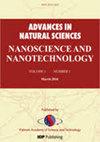Facile pore size control and low-cost synthesis of mesoporous silica nanoparticles based on rice husk
IF 2.1
Q3 MATERIALS SCIENCE, MULTIDISCIPLINARY
Advances in Natural Sciences: Nanoscience and Nanotechnology
Pub Date : 2023-03-01
DOI:10.1088/2043-6262/acc456
引用次数: 1
Abstract
We design silica from rice husk as a precursor for mesoporous silica nanoparticles (MSN), which is eco-friendly, low-cost, and abundant in availability, replacing tetraethyl orthosilicate, which is expensive and its vapours cause blindness, by the facile method, i.e., sol-gel. The different pore sizes of MSN have been successfully reached by tuning the synthesis conditions of surfactant concentrations and hydrothermal treatment temperatures. The smallest pore size of MSN is 2.62 nm, with the most significant surface area of 19.169 m2/g. The higher surfactant concentrations affect the decrease of particle size of MSN, but the higher hydrothermal treatment temperatures affect the opposite. In addition, these factors affect the morphology, the graph of isotherm, and the atomic elements of MSN. Thus, the resulting MSN will be applied to nanocontainers of corrosion inhibitor because of getting the small pore size.基于稻壳的介孔二氧化硅纳米颗粒的简单孔径控制和低成本合成
我们设计了稻壳二氧化硅作为中孔二氧化硅纳米颗粒(MSN)的前体,该纳米颗粒环保、低成本且可用性丰富,通过简单的方法,即溶胶凝胶,取代了价格昂贵且其蒸汽会导致失明的原硅酸四乙酯。通过调节表面活性剂浓度和水热处理温度的合成条件,成功地获得了不同孔径的MSN。MSN的最小孔径为2.62nm,最显著的表面积为19.169m2/g。表面活性剂浓度越高,MSN粒径越小,但水热处理温度越高,影响越小。此外,这些因素还影响MSN的形态、等温线图和原子元素。因此,由于孔径较小,所得MSN将应用于缓蚀剂的纳米容器。
本文章由计算机程序翻译,如有差异,请以英文原文为准。
求助全文
约1分钟内获得全文
求助全文
来源期刊

Advances in Natural Sciences: Nanoscience and Nanotechnology
NANOSCIENCE & NANOTECHNOLOGYMATERIALS SCIE-MATERIALS SCIENCE, MULTIDISCIPLINARY
自引率
4.80%
发文量
0
 求助内容:
求助内容: 应助结果提醒方式:
应助结果提醒方式:


